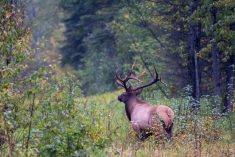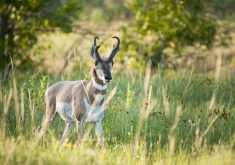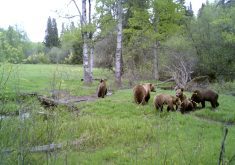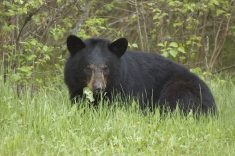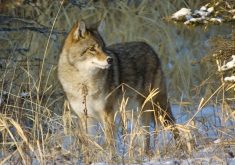Reports of cattle losses to wolves continue to come in from across the West. Official estimates indicate wolf populations are stable to expanding, but there’s really no way to know if that in itself is contributing to the reported increase in kills.
Claims history doesn’t reflect the trend because of its short history relative to the presence of wolves in Western Canada and the qualifiers involved in making claims.
Governments have offered wolf control measures since the settlement years but compensation for losses wasn’t introduced until 1974 in Alberta, 1997 in Manitoba, 2002 in British Columbia, and 2010 in Saskatchewan.
Read Also

Body condition, nutrition and vaccination for brood cows
One of the remarkable events of the past century related to ranching has been the genetic evolution of brood cows….
Each province specifies eligible predators and livestock, rules and rates. A common denominator is the need for a carcass as evidence of predation. The chances of finding enough of a carcass, let alone preserving the scene for a claims investigator to confirm the kill, narrows as scavengers clean up anything a wolf pack leaves behind. Missing animals don’t count even when recent predation has been confirmed and is the only feasible explanation for high death losses.
British Columbia Cattlemen’s Association (BCCA) general manager Kevin Boon says the wolf issue has been a priority and the one his association has spent the most time on lately because it affects so many members province-wide.
According to the B.C.’s 2014 Wolf Management Plan, the population is estimated between 5,300 and 11,600 with a best estimate of 8,500, compared with 8,100 in 1991, and 6,300 in 1979. Wolves inhabit most of the province, with the highest numbers in the Peace River and Skeena areas and they are now re-establishing in Kootenay, Okanagan and parts of the Thompson regions where they were considered extirpated in the 1970s.
The BCCA has a history with predation issues dating back to 2003 through 2011 when it implemented two successful Wild Predator Loss and Prevention pilot programs that laid the foundation for the province’s current plan, which is run by conservation officials (Canadian Cattlemen, January 2010).
The BCCA continues to monitor the threat via its voluntary annual survey of members and is now summarizing the first five years of feedback to identify trends.
“Raw data suggests the predation issue shifts from one year to the next, but the overall situation hasn’t really improved. One thing for certain is that the cost of predation has gone up,” Boon says.
Death loss isn’t the major cost. To that you can add the time lost treating injuries plus lost sale value, weight loss and lower conception rates among harassed cattle. One producer reported 200 of 350 cows open.
Well under 10 per cent of predation losses are discovered in time to qualify for compensation on B.C.’s remote forested ranches.
In response regional producer livestock predation committees are delivering verification training programs that teach producers how to photograph, identify and verify kills to make timely claims.
Saskatchewan’s compensation program also accepts detailed photos as evidence.
Alberta Beef Producers has created a flow chart to help producers navigate their way through five government agencies involved in delivering Alberta’s predator compensation program.
A recent study by the Miistakis Institute says 31 per cent of beef producers in Alberta have experienced some impact from wolves. The majority of successful compensation claims were for wolf kills and the majority of those happened along the eastern slopes and the boreal fringe.
Alberta’s estimated wolf population today is 7,000, well above the 4,000 winter wolf population the province’s 1991 wildlife management plan aimed to maintain. The plan is slated for an update that will include a new habitat-based population estimate.
Nobody actually counts wolves with this method. The condition of traditional wolf habitat and amount of prey relative to how much food a pack would need to survive in each type of habitat are rated and entered into a modelling program that rolls out the estimates.
In recent years Saskatchewan producers in spots along the boreal fringe have reported losses of 40, 50, 80 calves in a single grazing season, 300 calves and 28 cows in one rural municipality alone, and 128 head from a community pasture.
It’s been awhile since Saskatchewan’s official wolf population estimate was pegged at 2,700 to 3,000, says Mike Gollop, team lead with the province’s wildlife management branch. Based on the best available information, he says the population is trending to the high side and probably similar to Manitoba’s at 4,000 to 6,000.
“Saskatchewan is seeing and will continue to see more wolves on the Prairies because of the expanding distribution of populations to the east and south of the province and the traditional periodic encroachment from northern wolf populations. So maybe (it’s) wolves in more places, more so than more wolves,” Gollop wonders.
“One reason wolves are so successful as predators is that they can pioneer quite quickly into new ground,” he explains. “The old thinking was that they had to have remote areas to survive, but that’s not the case at all. The general consensus today, based on many studies, is that the only thing that limits the wolf population is the prey base. If they can find something to eat, they can live just about anywhere. They can very quickly accommodate people and survive in all types of habitat, just like coyotes.
“To put the problem into perspective, coyotes account for about 90 per cent of the claimed losses in Saskatchewan, but wolves can really hammer a producer because they can take cattle of all ages.”
Manitoba Beef Producers general manager Melinda German says predation on the whole, including wolves, is a significant issue in Manitoba. Producers are seeing more wolves and in pockets outside the hot spots of the Interlake and eastern region the number of wolf-kill and injury claims has increased. This could be due to a combination of there being more wolves and people being more familiar with the claims process.
A multi-stakeholder Livestock Predation Protection Working Group formed two years ago has been busy organizing workshops on claims procedures and wolf ecology for producers in problem areas. Work on a long-term strategy to reduce predation has started with a review of past research, and best-management practices in other jurisdictions.
Hank Hristienko, wolf manager with Manitoba Conservation, suspects it’s not the number of wolves, but the visibility of wolves that has increased with more people and more cattle moving into traditional wolf lands. His rough estimate for the current Manitoba wolf population is 4,000.
Overall, according to British Columbia’s Wolf Management Plan, Canada’s wolf population is currently seen as fully viable as wolves now occupy a majority of their historical range except in the Maritimes, where they are presumed extirpated. Wolf populations in every western province, Ontario, Labrador and Yukon Territory are ranked “apparently secure,” while Quebec’s wolf population is a notch higher at “demonstrably widespread, abundant and secure.” The Northwest Territories and Nunavut are not ranked. The grey wolf was designated as not at risk in 1999 by the Expert Committee on the Status of Endangered Wildlife in Canada.
When good wolves turn bad
Although many producers who have battled predation have been heard to say the only good coyote or wolf is a dead one, the idea that there are good ones of the live kind is gaining acceptance. Good wolves and coyotes are those that don’t prey on livestock, therefore, don’t teach their young to kill livestock, and their presence keeps those with a taste for livestock out of their territories.
“In Saskatchewan, the prime habitat for wolves is the boreal forest fringe. We have the most wolves there and the most problems with livestock there. It seems there are no problems for many years, then big problems for a few years, then it will be quiet again. Why, we don’t really know for sure. Something changes that causes a pack to key on livestock,” Gollop says.
It’s speculated that wolf predation has increased in recent years because of an increase in wolf numbers during a string of harsh winters that reduced ungulate populations, but hot spots of predation on livestock break out in areas with ample prey as well.
“Populations and problems may well be related but the correlation isn’t consistent,” says Gollop. “Circumstance is at least as important as populations.”
One circumstance is a change in pack dynamics when the alpha male or female dies and the pack breaks up. Wolves don’t usually survive for more than seven or eight years in the wild. They don’t have predators, but die from fighting with pack members for dominance or other packs for territory, hoof injuries from their prey, disease when densities are high, and most commonly from starvation, especially pups and young wolves. Lone wolves, which make up 10 to 15 per cent of the population, are usually yearlings or two-year-olds searching for new territories and they can cover long distances in a short time. It’s a vulnerable stage without the support of the pack for protection and hunting. Mortalities from trapping, hunting, removal because of depredation on livestock or to protect endangered ungulate populations, and vehicle collisions all contribute to the short lifespan.
Whatever the reason behind pack break up, the likely result is that multiple sub-dominant wolves breed and, if prey is plentiful, pup survival is likely to be high as witnessed in a Washington state study now in its 25th year.
This study confirms the principle of compensatory mortality. Simply put, a wolf (or coyote) that dies in one way can’t die another way. If one is shot another that may have starved will live, Gollop explains. It also confirms that each wolf killed increases the odds of depredation on sheep by four per cent and on cattle by five to six per cent.
Wolves were fully protected when the study began, however, when hunting was reintroduced, the ability of packs to respond when the population dropped was incredible, he adds. The eight dominant packs broke down into more packs with more breeding females that started breeding at a younger age, having larger litters and, because the prey base was stable, pup survival was good. The end result was a young, relatively inexperienced population that began to prey more and more on livestock.
In another 1970s-’80s study in the Simonette pastures of northern Alberta, every legal means was used to take the wolf population down to zero, but within eight months it was back to square one. This demonstrated the ability of wolves to travel great distances to fill vacant territories.
“So just fanning out and killing as many wolves as possible had a backfiring effect because the wolf population is so resilient,” Gollop says.
Other studies show that removing problem wolves is an effective way to curb wild ungulate and livestock losses in areas with high losses.
“If you have a problem pack in your own backyard, by all means deal with it,” says Gollop. “Ideally, take out the entire pack causing the problem and hope that the pack that moves in, because another will come, isn’t going to specialize on livestock.”
The Simonette study is still a standout in his mind because it provided some practical advice.
First, human presence is an important predator deterrent. Predation losses on the supervised part of the grazing reserve averaged three per cent compared to nine per cent on the unsupervised part where cattle were basically turned out into large forested pasture in spring and not seen until roundup.
Second, avoid turning pregnant cows out on pasture where wolves are known to kill livestock and, third, remove cattle from high-risk pastures before September. That’s the time when there are the most wolf kills because the pack’s energy requirements go way up as the pups are growing fast and they’re not experienced hunters, so not very helpful to the pack. All of a sudden there is a lot of extra stress and they’ll turn to livestock because livestock are easier prey than wild ungulates.
Melanie Dubois, a biologist with Ag Canada at Brandon and member of Manitoba’s Livestock Predation Protection Working Group, suspects it isn’t an increase in wolf numbers that sets the stage for predation to start, as much as changes in husbandry practices. Swath grazing, pasturing animals in new areas, or less human presence due to the addition of automatic watering systems in larger more remote pastures are three scenarios that come to mind.
Would altering or adding infrastructure be worth the time and expense? How much would the change reduce the predation risk? Those are questions Dubois hopes to answer with a cost-benefit analysis of various predation mitigation strategies. To that end she’s developed and field tested a predator risk assessment specific to wolves that was ready to go this summer. By scoring the features that favour predation and the vulnerabilities her assessment points out management practices that may lessen the threat. Suggested risk reduction measures will vary with the operation, the predator and the prey populations.
“A lot of producers have experience dealing with predation losses, but the advantage of a tool is having someone walk through the assessment with them to help identify factors they may not have been aware of previously and to provide information on predators in the area,” she says.
“A big part of the predation issue is the pressure on the family. It can be overwhelming. The assessment helps take the risk from everywhere and the inevitable, to being more manageable,” she says.





